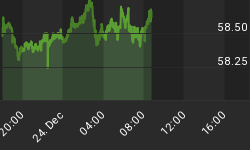Below is an extract from a commentary originally posted at www.speculative-investor.com on 21st February 2008.
Over the past few weeks we've devoted a fair amount of commentary space to the fact that gold stocks, as a group, have performed poorly relative to gold bullion over virtually all timeframes up to about 2 years. Additionally, we've noted that as a result of this underperformance the average gold stock recently became as cheap, relative to gold bullion, as it was at the May-2005 bottom, and that last week the GDX/gold ratio dropped back to its August-2007 low (which was, in turn, its lowest level since the second quarter of 2005).
Another way to view the situation is to compare the price of gold with the average valuation being assigned by the market to the in-ground resources of junior gold mining companies. This exercise has been done by Canaccord and it shows that since 11th October last year the rise in the gold price from $750 to $900 was accompanied by a 30% DECLINE in the average market value of the junior mining sector's in-ground gold resources. From a valuation perspective this would only make sense if the average in-ground gold resource had been dramatically over-valued to begin with or if the rise in gold's nominal price had been associated with a decline in gold's real price (gold's price relative to other investments and tangibles). Neither of these is true, so should we conclude that the gold sector's performance simply doesn't make sense?
Well, that depends on what is meant by "sense". It wouldn't make sense if the stock market were a machine that assigned prices based on an accurate measurement of value, but the stock market is not now and has never been such a machine. In fact, when it comes to value the stock market is totally clueless. Some analysts talk about the market as if it were an all-seeing, all-knowing oracle, but if that were true then dramatic price adjustments would never occur. That such price adjustments occur quite often reflects the reality that the stock market is, in effect, a manic-depressive mob that spends most of its time being either too optimistic or too pessimistic.
The stock market's habit of shifting from one valuation extreme to another creates excellent money-making opportunities, but you won't be able to take advantage of these opportunities if you blindly assume that the market is right or that past trends will continue. The market is like an emotional pendulum -- the further it swings in one direction the closer it comes to swinging back in the other direction.
Applying the pendulum analogy to the relationship between gold stocks and gold bullion, the best time to be intermediate-term BEARISH on gold stocks relative to gold bullion is following a lengthy period during which the stocks have been STRONG relative to the bullion and the emotional pendulum has reached an optimistic extreme (extreme optimism about the prospects of gold stocks), as was the case at the end of 2003 and during the first half of 2006. By the same token, the right time to be intermediate-term BULLISH on gold stocks relative to gold bullion is when the pendulum has reached the opposite extreme (extreme pessimism about the prospects of gold stocks) in response to a lengthy period of UNDER-PERFORMANCE by the stocks, as was the case in 2000-2001 and May-2005, and as is, perhaps, the case today. The point, in a nutshell, is that the best time to buy gold stocks is after they have been beaten down to the point where they are very low relative to gold and the majority has become convinced that the metal is the better investment.
In general terms, one of the main reasons why most people aren't able to outperform the market is that they get sucked into the market's current emotional state. They become increasingly pessimistic when they should be getting increasingly optimistic and become increasingly optimistic when they should be getting increasingly pessimistic. Along similar lines, the time when it will be particularly appropriate to question the common knowledge and to scrutinise the horizon for signs of a trend change will be after the emotional pendulum has traveled in one direction over an extended period.
Getting back to the gold stocks versus gold bullion issue, sometimes a dramatic sell-off leading to extreme relative under-valuation will be enough, in itself, to bring about a trend change. This was the case in April-May of 2005 when gold stocks plunged relative to the gold price at the tail-end of an 18-month consolidation. At other times there will be a specific catalyst that, when coupled with under-valuation, will bring about a trend change. This was the case in November of 2000 when extreme under-valuation combined with a major trend reversal in the US yield-spread laid the foundation for a large rally in the gold sector.
The current situation is similar to the final quarter of 2000 in that most gold stocks have become very under-valued relative to gold bullion and, as discussed in the latest Weekly Update, there is a potential catalyst for change in the form of a major upward trend reversal in the US yield-spread. The start of a large rally in gold stocks relative to gold bullion could still be a few months away, but the support structure for such a rally is in place. Therefore, investors should be getting increasingly OPTIMISTIC about the prospects for the gold sector.















